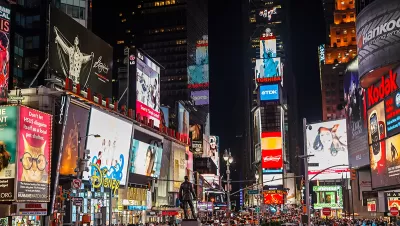Brightly lit pedestrian and commercial districts like Times Square and Shibuya Crossing in Tokyo are some of the most famous urban environments in the world. But that doesn’t mean they work in every city.

Mimi Kirk reports for CityLab on the efforts in Atlanta to develop a "bright lights district" akin to Times Square in New York. "The organization Central Atlanta Progress (CAP) is spearheading the effort to relax signage restrictions so that property owners can go bigger and brighter," writes Kirk.
Currently the city's zoning code caps signs at a maximum of 200 square feet. The group is pushing to allow bigger and brighter signs.
An earlier article by Amy Wenk reports on more of the details of the city ordinance that would enable the bright lights district. According to Wenk, the district "would stretch from the Georgia World Congress Center east to Piedmont Avenue, and from the attractions at Ivan Allen Jr. Boulevard south to Underground Atlanta. The district would include the new Mercedes-Benz Stadium, Philips Arena, The Tabernacle and Georgia Aquarium." The ordinance could go before the Atlanta City Council for a vote as soon as January.
In the article for CityLab, Kirk supplements a discussion of the details of the new ordinance with insight from Margaret Petty, head of the School of Design at Australia’s Queensland University of Technology, and Josiane Meier, lecturer at the Technical University of Berlin and co-editor of Urban Lighting, Light Pollution, and Society. Both those experts throw cold water on the idea that a bright lights district will attract tourists and visitors without additional key ingredients like density. There are also drawbacks to the environmental impact of bigger and brighter signs.
FULL STORY: Atlanta's Plan to Create Its Own Times Square

Planetizen Federal Action Tracker
A weekly monitor of how Trump’s orders and actions are impacting planners and planning in America.

Maui's Vacation Rental Debate Turns Ugly
Verbal attacks, misinformation campaigns and fistfights plague a high-stakes debate to convert thousands of vacation rentals into long-term housing.

Restaurant Patios Were a Pandemic Win — Why Were They so Hard to Keep?
Social distancing requirements and changes in travel patterns prompted cities to pilot new uses for street and sidewalk space. Then it got complicated.

In California Battle of Housing vs. Environment, Housing Just Won
A new state law significantly limits the power of CEQA, an environmental review law that served as a powerful tool for blocking new development.

Boulder Eliminates Parking Minimums Citywide
Officials estimate the cost of building a single underground parking space at up to $100,000.

Orange County, Florida Adopts Largest US “Sprawl Repair” Code
The ‘Orange Code’ seeks to rectify decades of sprawl-inducing, car-oriented development.
Urban Design for Planners 1: Software Tools
This six-course series explores essential urban design concepts using open source software and equips planners with the tools they need to participate fully in the urban design process.
Planning for Universal Design
Learn the tools for implementing Universal Design in planning regulations.
Heyer Gruel & Associates PA
JM Goldson LLC
Custer County Colorado
City of Camden Redevelopment Agency
City of Astoria
Transportation Research & Education Center (TREC) at Portland State University
Jefferson Parish Government
Camden Redevelopment Agency
City of Claremont




























